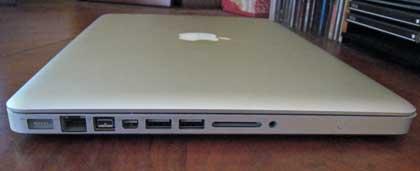
A side shot showing the ports on the 13-in. MacBook Pro, including the SD card slot on the right, next to the headphone jack.
When it comes to Apple laptops, what's in a name? More specifically, what does adding the "Pro" moniker to Apple's 13-in. MacBook mean?
It means that Apple again has three MacBook Pro models to choose from: this newly renamed 13-in. MacBook Pro, the popular 15-in. version and the larger 17-in. model. Best of all, the change comes with price reductions across the lineup -- the MacBook Pro line now starts at $US1,199 for the basic 13-in. model, with a slightly more tricked out version going for $US1,499. That's $US100 less than the respective MacBooks that preceded them.
With the latest update, the smaller Pro models not only get processor speed bumps, they also get a major improvement in battery life, an SD card slot, a FireWire 800 port, a better LED screen and, debuting in the entry-level version, Apple's highly regarded backlit keyboard. (As someone who used the 2.0GHz MacBook -- the one without the lighted keyboard -- for a couple of months, I can attest to the usefulness of the backlighting, especially with the black keys.)
The basics
The 13-in. MacBook Pro is the spiritual successor to the 12-in. PowerBook G4, which was discontinued three years ago when the company moved to Intel processors. The 12-in. PowerBook had a devoted following, and Mac fans decried its loss long after it was dropped. Although the 13-in. model is obviously a bit bigger because of the larger screen, it's close enough that fans of the smaller PowerBook should be satisfied -- at least until Apple offers up something like a netbook ( if it ever moves in that direction).
At first glance, the 13-in. MacBook Pro looks pretty much the same as the unibody MacBook it replaces. The ports, including the now-standard Mini DisplayPort for external monitors, are still located on the left-hand side of the chassis. Other than the Pro name and the addition of FireWire 800 and the SD card slot, not much has changed. This is a good thing, as the last model was one of the best-built laptops out there, thanks to the unibody manufacturing process Apple uses to carve these laptops out of solid chunks of aluminum.
The notebooks feel reassuringly solid and are relatively light, weighing in at 4.5 pounds. That's a pound less than the 15-in. MacBook Pro and two pounds less than the 17-in. Pro, making them perfect for toting around in a backpack on campus or at work. (The MacBook Air, which has the same size screen as the 13-in. MacBook Pro, still wins the light-weight honors, clocking in at 3 pounds.)
For review purposes, Apple sent over the top-end model, which comes with a 2.53GHz Core 2 Duo processor (up from 2.4GHz in the previous model), 4GB of RAM, the aforementioned SD card slot and, best of all, the integrated battery technology first unveiled in January on the 17-in. MacBook Pro.
New battery, same graphics
The additional battery life is probably the biggest and most useful change to the 13-in. models in terms of how people use laptops day to day. According to Apple, the battery will last for up to seven hours of on-the-go computing, though that figure doesn't envision a lot of hard-drive-intensive activity. With the screen set to half brightness, which is still plenty bright, and iTunes streaming music over Wi-Fi, I managed just over four hours -- not bad considering the continuous wireless stream of data and the fact that the screen never turned off. If you use the more aggressive "longer battery life" settings in the Energy Saver preference pane -- and go easy on the streaming WiFi -- you can extend that time, though I've never been able to hit Apple's optimistic estimates.
The use of the built-in battery means that all of the MacBook Pros now use the adaptive charging technology Apple introduced in January on the 17-in. model. Though some Mac fans dislike the integrated approach, Apple says the new battery should last for 1,000 full charge cycles -- enough to go for about five years if you assume four full charge/recharge cycles a week. Since the technology is new, it's too soon to tell whether that estimate will hold up over time.
Both of the 13-in. MacBook Pros, as well as the entry-level 15-in. model that goes for $US1,699, rely on the now-ubiquitous Nvidia GeForce 9400M video processor to push pixels. The 9400M can use up to 256MB of system RAM and drive an external monitor at 2560 x 1600 pixels.
I'm not a gamer, so I can't vouch for Apple's claims that the integrated Nvidia processor is between 2.5 and 6 times faster than the Intel GMA X3100 graphics chip used in the previous-generation MacBook for games like Unreal Tournament and Call of Duty. But I can tell you that video playback was top-notch, even for high-definition files.
Apple must really be happy with this GPU, because the 9400M is in every one of its laptops, including the MacBook Air and the 17-in. top-of-the-line MacBook Pro. In the more expensive models, it's paired with a discrete chip, the Nvidia GeForce 9600M GT.



